As an avid Netrunner player, there is no part of the game I enjoy more than arguing about balance and design. In the run-up to, and aftermath of, Worlds (where NBN took sixteen of the top sixteen while Anarch took fourteen of the top sixteen places) there was no shortage of discussion about the woes and problems of balance in Netrunner. Midway through SC season, approaching six months after the last MWL, and with Magic seeing its first Standard (the main focus of Magic developement / design) bans since 2011, I felt it was a good time to share my thoughts on Netrunner’s balance and what can be done to fix it. Despite the dominance of two factions, I still found Worlds a highly competitive and enjoyable tournament that I was glad I went to. I’ll break this article into two parts, the first discussing the current state of balance and why things look like this, and the second discussing how the current problems with balance should be approached to be fixed.
What is Netrunner Balance?
There are three high-level components of Netrunner balance, which I have listed in order of importance:
- Corp / Runner balance
- Diversity across Factions
- Diversity within factions
The Netrunner Worlds meta failed at #2, succeeded at #1, and succeeded at #3 (there were ~three Anarch archetypes and ~four NBN archetypes in the top 16). Despite achieving #3, people would largely not call this a diverse meta, because even different decks in the same faction tend to play more similarly than decks in different factions. Additionally, lots of people have styles of play they prefer that are only represented in one faction (or they might have thematic reasons to favor a faction). Beyond what decks you can pick, having a wide variety of decks you can expect to face is part of what makes Netrunner such a great game, where every matchup feels so different even when playing the same deck (RP vs Noise felt different to Andy, and in turn different to Kate).
However, despite the importance of having diversity of factions in the health and fun of the game, as a competitive player the most fundamental requirement is balance between the two sides. When the sides get out of balance, the outcome of a game is less skill-dependent and playing the weaker side often becomes a miserable endeavor of just hoping to get lucky, whether that’s in the matchups you get or within play itself. You want every game to feel close and largely decided around play, and the most important part of that is getting the sides to be roughly equal.
The final part of balance, Diversity Within Factions, is the least important of the three. It’s largely important in the long run, where people are okay with Andysucker being the only deck in criminal, but were upset that Andysucker was the only deck in criminal for over a year. The game can be healthy and people will enjoy it even in metas where there is only one option in a faction, as long as that one option does not stay the only option forever.
Understanding Side Balance
One of the first things to understand about side balance is that in the platonic ideal game of Netrunner the Runner is a huge favorite. Or, with both sides having money, Ice and breakers, and Agendas, the Runner will win the vast majority of the time. If the top players go back with the knowledge we have now, core set Netrunner relies on the Runner getting a bad draw and getting gear-checked into oblivion, or the Corp getting a game changing Accelerated Beta Test, lucky Snare! access, or perfectly-timed Archer. The runner is able to win simply by building up a board state that is able to contest a remote three-four times, and it’s extremely difficult for the Corp to build a remote that can withstand a runner who takes money and finds breakers, without giving up a massive amount of central accesses. What allows the Corp to bring things closer to even is its ability to drastically change the rules of the game away from scoring in remotes through cards that allow different scoring or win conditions. Caprice Nisei, SanSan City Grid, Biotic Labor, AstroScript Pilot Program, Breaking News, Exchange of Information, Scorched Earth, Midseason Replacements, 24/7 News Cycle, Bio-Ethics Association, Ronin, Mumbad City Hall and Accelerated Diagnostics are some of the most complained-about cards in Netrunner, but are also the cards which are crucial to having a side-balanced metagame. It’s important to note that some of these cards are too strong and need to be dealt with, but fundamentally you need some of them to exist at similar power levels in order for the Corp to not be a massive underdog.
This reliance on powerful win condition cards has meant that Corps are way more vulnerable to hate cards (cards that target a specific card or strategy to negate) on the Runner side (with Runner hate cards typically neutralizing Corp win conditions). Scarcity of Resources came out before Worlds and despite targeting a crucial part of Temüjin Whizzard’s deck (their resources), it did not see much impactful play at higher competitive levels. Meanwhile one Runner card (Rumor Mill) that targets 3-4 cards in a Glacier deck and is typically featured as a one-of erased Glacier from competitive play. I wasn’t around for the beginning of the game, but my understanding is that Plascrete brought Weyland down from the clear best faction to an okay one immediately upon its release. Slotting Feedback Filter in Andy or Deus Ex in Kate turned 2014 Worlds PE from a deck that went undefeated at Worlds to a deck that could barely win any games.
Worlds 2014, probably the most Corp-favored meta of all time, had NEH, RP, PE and even Blue Sun all forcing card slots to beat them and preventing a runner from teching too hard against any one win condition (with almost no pure hate cards available against NEH or RP). Worlds 2015 had Haarpsichord, NEH, and Foodcoats all requiring different strategies, cards and tech but in a fairly side-balanced meta. Worlds 2016 was unusual in that there was basically a known best deck on each side (Controlling the Message [CTM] and Temüjin Whizz) and despite each side being prepared, the matchup ended up being a roughly even. Boom! decks forcing Runners to slot Plascrete slightly cut down on the amount of CTM hate, but for the most part 2016 Corp/Runner balance was achieved almost solely on the power of one deck (CTM) being able to handle all Runner decks. As more CTM and Tagging hate cards (Citadel, On the Lam, and now Aaron) have been printed, CTM has moved closer in line with the other Corp options, and Corp has gone from bad to worse.
Why was CTM the best deck?
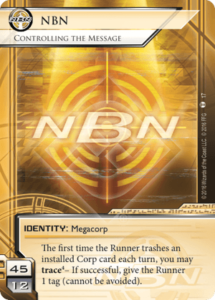
When understanding Corp balance, the first question is why CTM was the best deck at Worlds. It was the best deck because it has multiple strong win conditions (Asset Spam, Fast Advance, Tags) that a deck had to deal with in order to beat it. Whizzard could often deal with the Assets and Tags (slotting Slums or Employee Strike to help with both of these) but had no means of preventing Fast Advance either with Exchange of Information or simple 3/2’s. Shaper decks would struggle with the assets, and this would mean that CTM went so fast that Clot was not good enough to stop the combined Fast Advance and Remote game. CTM posed so many threats and was extremely resilient to hate (which most decks were packing). Additionally, CTM had largely even matchups across the field of Runner decks at Worlds, which means there was plenty of room for another Corp deck to be stronger. So the question is why weren’t the other Corp decks as good as CTM?
When understanding why other decks were bad, the key thing to be aware of is the ways in which Corps have tried to subvert the standard model of the game (win conditions). Understanding these win conditions and why they struggle is key to understanding why CTM was the strongest deck. I’ll list out what I consider to be the win conditions that have existed in Netrunner, and then break down the problems I think they have in the current cardpool.
- Glacier (strong Ice + defensive upgrades)
- Rig Shooter (program trashing + speedy gearchecks)
- Net Damage Kill
- Meat Damage Kill
- Asset Spam
- Fast Advance
- Tag Storm
- Traps
Most decks are a mix of several of these (CTM is Asset Spam + Fast Advance + Tag Storm), but some are entirely based around one of these strategies (non-kill SYNC decks are mostly based entirely on Tag Storm).
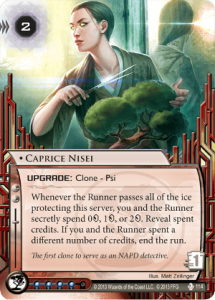
Glacier
The problems with Glacier in the current meta are twofold:
- It is weak to strategies that can very cheaply run the scoring remote, with Ice destruction being the most prevalent form of this. Anarch is running rampant over the meta and is able to destroy Ice and assemble a very efficient rig that Glacier has a hard time taxing out, even when defensive upgrades are present to force the Runner to run the server multiple times.
- Rumor Mill is extremely powerful against Glacier, and Glacier is unable to win without forcing more than just 3-4 scoring runs on a remote server. Rumor Mill also falls in the faction that was already strongest against Glacier, and a Temüjin Whizz with only 1 Rumor Mill goes from a slight favorite to a massive favorite in the matchup.
Both of these problems are fixable, and as recently as Gencon 2016 (before the release of Rumor Mill) Glacier still was a notable part of the top Meta, but was not the strongest Archetype. Making Anarch slightly less powerful overall, and getting rid of Rumor Mill (and maybe Political Operative) would allow Glacier to move back into the meta.
Rig Shooter
Rig Shooter decks have been pushed out of the meta ever since Criminal stopped being the only competitive faction. Due to the fact they don’t run defensive upgrades the way Glacier does, and intend to score some of their points out of a remote, they’re extremely weak against strategies that are good against gear checks. This means they’re weak against strong AI breakers (Faust), as well as cards such as Blackmail or DDoS that completely avoid breaking ICE altogether. Additionally, Shaper has always dealt with them well due to the power of Clone Chip and SMC to deal with trashed breakers and gear checks. For Rig Shooter to become at all prominent again, some of these things likely have to be dealt with. However, the card pool does not look completely hopeless for Rig Shooter. Ark Lockdown represents a card that lets it prevent recursion. One of the upcoming spoiled cards, Hunter Seeker, is a very powerful trashing card that greatly strengthens the Corp’s ability to trash the Runner’s rig. However I think it likely isn’t going to be strong enough to fix the overarching problems of Faust and Blackmail.
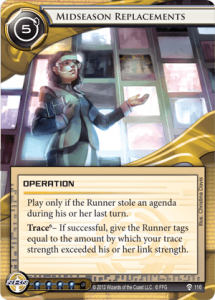
Tag Storm
Tag Storm is a deck archetype that seeks to force the runner to float a bunch of tags (or be taxed by removing them) and then utilize win conditions based around that, and has been the strongest and most prevalent force in the meta for about six months. SYNC and CTM have been the two decks to beat ever since 23 Seconds came out. Personally, I find them interesting and fun to play against but I understand there are some ways in which they are problematic (which I’ll discuss a bit later). However, despite their dominance they’ve become less powerful as the cycle has gone on due to the proliferation of Temüjin as well as the amount of strong tag hate cards that have recently been printed. The latest of these, Aaron Marrón, is one of the strongest hate cards ever printed in Netrunner. He’s incredibly powerful in the Tag Storm matchup, while having strong utility in other matchups. Many people have been rejoicing at the prospect of never getting hit by Breaking News shenanigans again, but this has the side effect of completely obliterating the last Corp deck that had a reasonable winrate against the runner field (as well as the strongest tool Corps had for attacking the Runner).
Net Damage Kill
Both PU and IG are semi viable at the moment, but suffer from having strategies that beat them soundly (and are currently in the meta). Slums, Strike, and I’ve Hard Worse are very strong against the current Net Damage decks, and all of these have a fair amount of play in meta decks. Long term, Net Damage is a strategy that has never been dominant as it is probably the most vulnerable strategy in the game to hate cards. Feedback Filter, Deus Ex, and Levy AR Lab Access add such power against these decks that Net Damage has never been able to represent more than a fraction of the meta without runners teching hard and making it miserable. The Top Deck games between Vine Gary Mink and Selverin are notable examples of what happens when someone is prepared for Net Damage and brings a single Feedback Filter. Once that card drops, Selverin basically has no chance despite being in an otherwise advantageous position. I once asked Jinteki God of Death Chris Hinkes what card he would design if he could, and it was essentially a card that removed Deus Ex and Feedback Filter from the game.
Meat Damage Kill
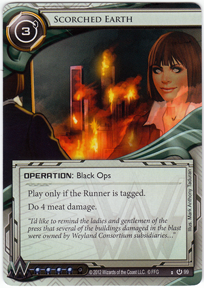
Meat Damage was the second most common win condition in the top 16, with Ben Ni coming in second with a kill list as well as several other NEH kill lists. It often overlaps with Tag Storm, but is distinct in that you are trying to get tags on the opponent for just 1 turn and then kill them, rather than a continually taxing tag plan. The reason that these decks were strong is that they had finally got enough tools to kill through plascrete. Shutdown boom was able to deal 14 meat damage in one turn, and Ben’s Sync list was able to destroy plascrete reasonably well. As meat damage overlaps with tags, it can also be vulnerable to tag hate. Tag storm is usually vulnerable to hate that lets you efficiently remove tags, while Meat damage is vulnerable to hate that can prevent or remove tags on the Corp’s turn. New Angeles City Hall was probably the strongest of these, but it inherently gives a mechanism to be removed as it gets trashed on score. Meat Damage was successful because its primary win condition was resistant to the hate that existed. However, moving forward Aaron and On the Lam both represents cards that are extremely difficult for Meat Damage decks to beat, and Meat damage has largely been pushed out of the meta since Worlds.
Asset Spam
At its core, Asset Spam is about installing so many must-trash assets that the runner cannot keep up dealing with them. The must-trash assets are typically either win conditions like SanSan and Bio Ethics, or cards that accelerate the number of cards installed, like Sensie Actors Union and Mumbad City Hall. Typically, a standard Runner doesn’t have enough money to trash everything that is installed and has to prioritize trashing a subset of key cards and then try to race on accesses. However, the proliferation of Whizz as well Temüjin (with Desperado also being very strong) has put a damper on pure Asset Spam strategies.
Fast Advance
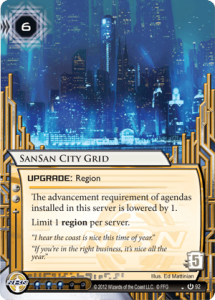
Fast Advance is probably one of the strongest win conditions at the moment. There aren’t many competitive Runner decks playing Clot, and the decks that can use Clot the best, such as Shaper, are in a weak spot. Additionally, Clot has strong counterplay in several existing cards that are good in their own right (Cyberdex Virus Suite, Shipment from SanSan), and can interact by purging without needing any cards. However, relying on Fast Advance as your only win condition is difficult right now without the power of the Astrotrain, so most Fast Advance decks will involve some amount of other win conditions. The HB FA decks often score some points out of remotes, while the yellow FA decks often utilize tag punishment and Exchange of Information. CI7 is a notable FA deck that is seeing an increase in play as everyone tries to find Corp decks whose win conditions haven’t been completely neutered.
Traps
Advanceable traps have been an often maligned win condition, but they have been part of a couple strong decks over the course of Netrunner. The strongest trap is Cerebral Overwriter, as giving someone three or four brain damage often makes it trivial for a Corp with net damage to kill the Runner. The most successful pure trap decks tend to operate on maximizing the amount of Mushins that happen, because the payoff structure for any trap that is not Mushin’d tends to be really bad (it’s more expensive, and two brain damage is not nearly as good as three for killing the Runner). There has not really been any notable successful usage of traps in decks that try to advance out of a Remote, and the big reason for this is they tend to be inferior to defensive upgrades. The strongest part of the trap is that you can bait a taxing run through the server, but Ash and Caprice do that on their own. Additionally, both Ash and Caprice let you compress the clicks, and they work even if the Runner doesn’t Run the server (as you’ll get to keep the upgrade rather than having to install over it). Finally, Expose effects tends to completely destroy any sort of trap deck, and this prevents decks that rely too heavily on traps to ever be a sizable chunk of the meta.
Corp Win Summary
These are the main ways that Corp decks have won games throughout Netrunner’s history. Not all of these have to be good or in the meta at once, but it is important to a healthy and diverse metagame that several of these are viable at any given time (or potentially new win conditions!). Which decks are best for the game is largely a judgement call, and it’s important to recognize that one’s own preferences are not universal (I enjoy Glacier the most and don’t like Fast Advance). The best solution to this is to try and make sure a variety of win conditions are on similar power level, so everyone can play their favorite kind and no one will spend all their time playing against their least favorite thing. However, I will say that I think it’s extremely important that in any given meta one of Rig Shooter or Glacier is a meaningful chunk, because I believe these decks are the closest to what we imagine as Netrunner (scoring out all the points behind Ice in a remote). While I think it’s important to have these in a healthy metagame, I think the most important aspect of a healthy metagame is a variety of strong Corp win cons, all around a similar power level.
Runner Balance
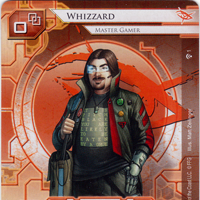
Now, I’ve largely talked about the Corp side balance and how and why it’s largely Runner cards that are currently dictating the small number of Corp options. The flipside of that is understanding how Runner options are limited by the Corp meta. Currently the meta is primarily Anarch with a smattering of Criminal and barely any Shaper. So CTM makes for an interesting case study for how a Runner deck might be pushed out of the meta. The biggest way CTM limits Runner decks is the power of its turn 1 asset protection. Taking and clearing a tag or paying three or four credits to avoid taking it is extremely hard to do while staying safe from Hard-Hitting News and developing your own board. So there are basically three options for dealing with CTM from turn 1.
- Float tags permanently (Siphon decks, Anarch / Criminal)
- Have enough frontloaded econ that you can trash something turn 1 and be above HHN range (Andy / Whizz)
- Let turn 1 assets go for several turns (Shaper plan)
At the moment, plan #3 (let turn 1 assets go for several turns) simply doesn’t work, largely because of the strength of Sensie Actors Union firing even once. If it fires, a Shaper can easily end up looking at three-** new remotes which it has no chance of trashing on Turn 2. This spirals the game out of control, and ends up with the Corp quickly creating a decently taxing Tollbooth remote before Shaper can get set up to contest. Without SAU, Shaper can plausibly let DBS or Commercial Bankers Group run for several turns without getting so far behind they can’t win.
Ultimately what ended up happening is any deck that didn’t have the frontloaded econ of Whizz or Andy, or the ability to go tag me was pushed of the meta. It’s okay if decks have bad matchups, or struggle against a particularly strong meta deck, but it’s generally a problem when an entire faction cannot compete with the dominant deck. While the overall power level of CTM might be fine, its power level against this wide range of Runner decks is problematic for Runner side diversity.
Conclusion
Achieving balance in Netrunner is tricky due to the asymmetrical and multifactional nature of the game. Balancing either of these two things affects the other one, as making a faction weaker also makes that side weaker. Additionally, at its core Netrunner is an unbalanced game where one side (Runner) has a serious advantage over the other one. Corp needs tools to break the standard model of the game and turn it into something where they can win. These tools, or win conditions, are some of the strongest cards in the game and very often the target of outrage. When balancing the game, it is important to be careful when balancing Corp cards as when you counter them too well or make them too weak Corps will struggle to win at all. That is where we are at right now with every major Corp win condition struggling due to the power of hate (or in some cases simple weakness). Overall, I’ve spelled out what I think are the issues with balance and in my next article I’ll talk about what I think can be done to fix these issues.




